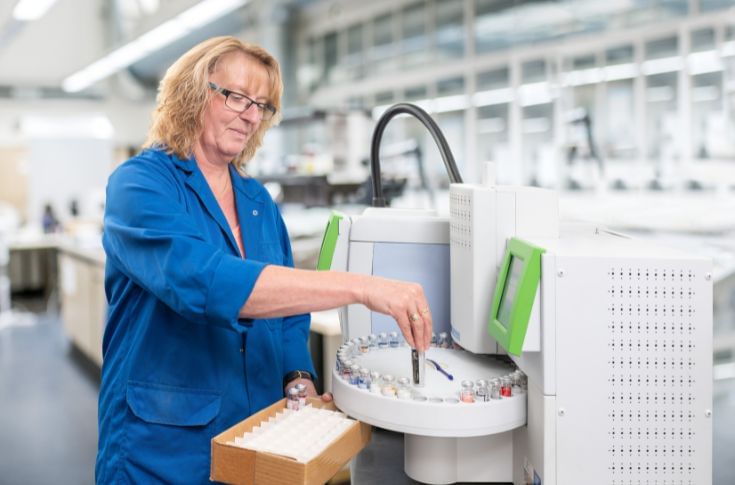Food packaging 2.0 with Huber’s DFC inks and coatings
Brands looking to restructure their packaging design, face challenges to print on smaller designs. The DFC inks and coatings allow them to print in areas which they could not have done before. Richard Gill, product manager - sheetfed, Hubergroup, talks to Abhay Avadhani
29 Nov 2023 | By Abhay Avadhani
Abhay Avadhani (AA): When was DFC inks launched?
Richard Gill (RG): It was launched officially in 2022, and we've had a lot of interest from brands and design agencies.
AA: Why?
RG: It enables them to print on different areas of the packaging that they could not before.
AA: In what way?
RG: We're not replacing one type of ink with another and then printing the same design. Because it is in a sensitive area of the packaging, where it can be in direct contact with food, people are doing their due diligence to make sure everything is safer.
AA: How is it different from the other printing inks?
RG: Normal inks are suitable for food packaging on the outer side; not in contact with food. In the case of DFC inks, where you have the food in direct contact, the food can have a direct influence on the ingredients of inks like the pigments, oils and the resins used. In a normal packaging scenario, or design, this doesn't happen. You get what we call migration, which is a transfer of substances from the ink to the food, but there's no direct influence by the food on the ingredients.
AA: What parameters should the packaging converters consider while using the inks on the press?
RG: We have to take extra care with the raw materials to make sure that they are all safe and suitable for direct food contact. Also the level of purity of the ingredients is important. We should be aware about exactly which materials we use to make sure no unintended substances are used. From our point of view, it's about selecting different raw materials, and materials with a high level of purity. So we know that they're safe for the food to be in contact with.
AA: What are some of the ink standards in Europe that are deployed for packaging materials, and which are in contact with the food? How does DFC inks comply with these regulations and standards?
RG: There are only regulations that are to do with the actual packaging itself. But we have to make sure that the products we supply will let the converter meet these regulations. So all of the regulations are to do with the actual packaging itself. In this case, there are some guidelines for inks, but the Swiss Ordinance is the only regulation. It's only strictly applicable in Switzerland. Because there's no other regulation specifically for inks, it becomes the de facto standard. We make sure with the DFC, that all of the ingredients used are suitable and listed for direct food contact themselves. We support the customers through the development stage, to show that by using these inks, the packaging at the end will be compliant. At the end, it's the compliance of the packaging that matters to the person taking the food home.
AA: And how do these inks perform in terms of cost?
RG: Because of the special raw materials, we have to have high levels of impurities, for safety reasons.. They are more expensive than other ink for food packaging, that's not direct contact. But we find that brands and customers are not looking at this in terms of replacing one ink technology with another. They are using it to create new types of packaging as they can print in different areas.

DFC inks enable to print on different areas of the packaging that they could not before
AA: As in?
RG: For example, with a particular type of water-based coating, converters can replace the plastic liner in the carton board for some packaging and food types. In some ways, they spend more on inks, but can save money on the material they're printing on, and they can take away the need for a plastic layer as well. So the substrate or the overall packaging becomes less expensive.
AA: What are the other such advantages?
RG: The other benefit would be from a sustainability point of view. Customers try to make their overall packaging smaller, and they use less material. It costs less to transport it. By printing on the inside with DFC inks, they have more opportunities with less usage of material. If you compare the price per kilo for the food packaging ink to the DFC, DFC is more expensive. But if you look at the effect, they can end up with an overall lower cost of packaging.
AA: What are the parameters to be considered while using DFC inks and coatings?
RG: Some of the colour shades are a little bit different. So a normal process series will be yellow, magenta, cyan, and black. We have the same principle with these but because we have to choose slightly different pigments, the colour shades are slightly different. So another parameter to take care of, is the changeover from a non DFC printing job to a DFC job. This is to make sure that the whole thing is completely washed up.
AA: And how do they perform on packaging with different shapes and sizes?
RG: We are looking at carton boards, it is mainly a part of the board application. It also works in combination with a water-based coating, in terms of visual effects of gloss or matte finish. You would see more differences depending on the type of substrate whether it's the coated or non-coated side of the board.
AA: What are the packaging challenges that these inks are addressing? And how are they helping overcome?
RG: The two biggest challenges are brands moving away from plastic and reduction in overall packaging size. So they are either moving from plastic packaging to a completely paper based packaging, or a paper based packaging with a plastic layer. There's a trend from an environmental perspective to take away plastic. After the printing is done, a plastic layer is applied on top of the surface to prevent the ink from getting in contact with the food directly. With DFC inks and water-based coatings, it eliminates the usage of plastic layers in some applications.
Richard Gill, product manager - sheetfed, Hubergroup
AA: What are the overall challenges faced by the packaging companies?
RG: Converters are making the overall pack smaller even if the food stays the same size or the same weight. This means on the label, you need to have the necessary information. With a smaller pack you have less opportunity for brand designs, marketing promotion, and making a generally attractive packaging. With DFC inks being able to print inside, and in different areas, you can create a more sustainable and smaller packaging.
AA: How are these inks and coatings helping in overcoming design challenges?
RG: Designers like to try to maximise the effectiveness of the packaging. If there are certain areas of the packaging that they're not allowed to print, it limits the possibilities in terms of the design. It gives them more options in terms of creating something that's attractive or a surprise packaging. For example; for chocolates or sweets packaging, the unboxing experience can include a message underneath the food.
AA: How do you ensure the safety of your inks for consumers when using packaging for labelling food products?
RG: We choose the raw materials, especially for direct contact, and we manufacture them in separate areas of the factory. We have a dedicated area of the factory which only handles the direct food contact materials. There's no chance of contamination from standard inks that aren't for DFC. We're members of the European Printing Ink Association, we have guidelines on how to make inks for food packaging. At the end, we always have to give a statement to our customers that says, we formulate these things in the right way, we manufacture them separately, and we follow these guidelines.
AA: Can you share examples of companies which have been using your DFC inks? What is their feedback?
RG: The feedback has been nice in a way that they don't have to make any changes to their printing machines. The printing speed is the same, how they perform according to the operators, and the input is the same.
AA: Which segments are they eyeing?
RG: The areas where they are looking at for the development are packaging for bread, bread products, pastries, fruits and chocolates. For fruit, you might go to the supermarket or to the fruit shop, and you get your fruit in a clear plastic tray, or maybe a cardboard board that's not printed. So it's functional, it does a job, but it's not attractive. But with DFC inks, the packaging can be made attractive, with more potential areas for printing, and utilise the package. This makes it look brighter, more colourful, which enhances the appeal of the fruit itself.
AA: And that also depends on the market right. So what are the noticeable differences in the European and Indian market?
RG: People want to do the right thing in terms of safety for the consumer. But the word sustainability is such a big topic everywhere. People are still looking at how they can make the packaging more sustainable, more environmentally-friendly, and how they can make the packaging as attractive as possible.
AA: Any restriction of DFC things with regards to colour gamut? Is it able to produce all the colours?
RG: There is a slight restriction. It is a slightly smaller colour gamut. And this is one of the reasons for us working in partnership with our customers in the development is important. Then we can advise them on which colours might be possible, and which ones might be a little bit difficult. So it's not just replacing one type of printing with another. It's printing in new areas with new designs. There is a slightly smaller colour gamut because of the more restricted pigments we have to choose from.
AA: Finally to sum up succinctly, what are the advantages of DFC inks?
RG: DFC inks can be used to produce more attractive and sustainable packaging. DFC inks with two additional colours - Y+M+C+BK+V+O can be used for offset printing with extended colour gamut (ECG) and there is no requirement of any special shades. By using DFC inks, you can minimise machine downtime as no cleaning activity is required like in special colour job printing.
DFC and MGA Contact inks - At a glance
An overview of the direct food contact inks
Conventional sheetfed offset inks for printing on food, beverage or tobacco packaging were developed for printing on the side, facing away from the food. These inks are not intended for printing on the inside of food packaging, where direct contact with the food cannot be ruled out. There are hardly any inks for such applications with direct food contact.
Hubergroup’s new sheet-fed offset series MGA Contact, however, is suitable for direct food contact applications. No functional barriers are required. The ink series only needs to be coated with a water-based coating that is also suitable for direct food contact. It is, therefore, suitable for safe printing on the inside of paper and board for food packaging.
Selection of basic raw materials for formulation of DFC inks is the most important part of the product design. Special care is taken in the selection of pigments, resin system, reducers and additives to meet stringent regulatory compliance related to DFC.
These DFC inks are manufactured at a dedicated plant in Germany. Apart from four process-colour inks, Huber offers two additional colours; orange and violet for extended colour gamut (ECG).
Suitable water-based coatings mandatory for MGA Contact inks
MGA Contact inks are low migration and low odour type which are based on a completely non-oxidative drying system. These inks dry purely by absorption process on paper and board substrates. During printing in-line, water-based coating is required to protect the wet ink film.
In food safe package printing by offset, apart from the printing inks, there are other consumables used. All the other consumables like fount concentrate, spray powder, wash, water-based coating and glue should be of the same quality and suitable for food safety printing.
R&D to improve the safety and performance of the inks
There are always diverse requirements in food packaging for direct contact applications where components from the food items will directly interact with the printing ink layer. Some foods are acidic in nature whereas some are alkaline, some food may be alcoholic in nature, and there are some fatty and oily foods. Depending on the various food types, you need different functional barriers. Hubergroup now offer inks and coatings, which are suitable for dry and fatty type food packaging. Continuous development work is going on for other food types.

As a result of gas phase transfer, the migration of mineral oil takes place from secondary packaging into the food. How does team Humber ensure this problem is mitigated?
Low molecular weight mineral oil, if used in the offset inks formulation, can migrate easily. This happens either through paperboard on which the printing is done, or as a result of gas phase transfer when the food items are not even in direct contact with the packaging material. MGA Contact inks are designed with a clean formulation approach. These inks are mineral oil-free, drier-free and based on pigments having high resistance properties, suitable for package printing. There is no possibility of mineral oil migration from the DFC inks.



